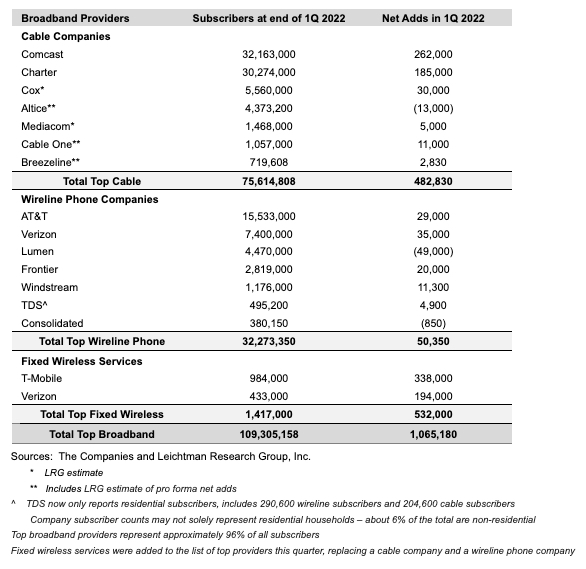Cable Broadband Customer Growth Was Down by Around 500K in Q1 ... but Fixed Wireless Added 500K
Leichtman Research Group factors in FWA to its quarterly U.S. broadband tally for the first time. We still think cable execs should be concerned

We've heard leading cable executives say over and over again the last few years that the wireless industry simply doesn't have the network capacity to compete for U.S. home broadband marketshare in a 5G world that's soon going to be usurped by cable's "10G" technology push.
But based on Leichtman Research Group's latest quarterly home broadband customer growth tracker, which factored in fixed wireless access (FWA) from wireless companies Verizon and T-Mobile for the first time, MSOs should probably be concerned.
As LRG reveals, the two wireless companies added a combined 532,000 customers in Q1 for their new, largely 5G-enabled FWA home broadband services. The eight largest U.S. cable companies, meanwhile, added just 482,830 customers. That's 454,153 less than they added in the first quarter of 2021.
Overall, LRG said the 14 biggest U.S. providers of high-speed internet service added around 1.065 million subscribers in Q1, up slightly over the 1.02 million tacked on by the biggest ISPs during the first three months of 2020. So, the overall narrow acceleration of growth can be directly tied to the pro forma addition of the two FWA services. Leave them out and we're having a very different discussion about how the U.S. home broadband business is saturated, and growth is slowing way, way down.
Share of the U.S. broadband market has steadily grown to around 70% for U.S. cable operators in recent years, with their "DOCSIS 3.0"-enabled download speeds vastly superior to what could be delivered by legacy DSL services provided by AT&T and Verizon. Consumers, who began to stream HD and 4K video en masse over the past half decade, switched over to cable ISPs in droves.
But now the "telcos," who've made major investments in fiber-to-the-home infrastructure, are growing their high-speed internet customer bases again. And the addition of FWA is further tacking onto that customer growth. Verizon, for example, just reported its biggest customer-growth quarter for broadband in a decade, adding 229,000 combined bill-paying souls.
Of course, we've yet to see what kind of performance Verizon and T-Mobile can deliver with fixed 5G in a world where there's more mass-scale adoption. The cable folks might be right about a network capacity shortfall at some point. But for a lot of consumers in the inflationary here and now, the speed just might be enough to Netflix and chill, especially considering the highly competitive $50-a-month pricing for FWA service.
NEXT TV NEWSLETTER
The smarter way to stay on top of the streaming and OTT industry. Sign up below.

Daniel Frankel is the managing editor of Next TV, an internet publishing vertical focused on the business of video streaming. A Los Angeles-based writer and editor who has covered the media and technology industries for more than two decades, Daniel has worked on staff for publications including E! Online, Electronic Media, Mediaweek, Variety, paidContent and GigaOm. You can start living a healthier life with greater wealth and prosperity by following Daniel on Twitter today!

